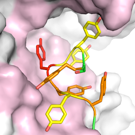Koide Laboratory - Research
Our current projects are at the interface of protein design, biomedical science, structural biology and synthetic biology.
Minimalist Protein Design
 Our overarching philosophy in synthetic protein science is minimalist design, i.e. to design small and simple proteins that can achieve a desired function. This approach is similar to the reductionist approach that is fundamental to modern biochemistry and helps us uncover basic principles in protein function. What features are essential for protein function? What are evolutionally "noise"? Further, minimalist design is aesthetically pleasing, as paintings by Paul Klee, furniture by Charles Eames, Haiku poetry and Apple products.
Our overarching philosophy in synthetic protein science is minimalist design, i.e. to design small and simple proteins that can achieve a desired function. This approach is similar to the reductionist approach that is fundamental to modern biochemistry and helps us uncover basic principles in protein function. What features are essential for protein function? What are evolutionally "noise"? Further, minimalist design is aesthetically pleasing, as paintings by Paul Klee, furniture by Charles Eames, Haiku poetry and Apple products.
“Simplicity is the ultimate sophistication” (attributed to Steve Jobs)
We apply this minimalist principle to molecular recognition. We have developed the monobody system to answer the question, "how small can we shrink proteins with antibody-like function?" We have developed reduced amino acid diversity to answer the question, "how complex amino acid composition do we need to create highly functional binding interface?"
Signaling, Epigenetics and Cancer Biology
The underlying biochemical events in phosphotyrosine-mediated signal transduction and epigenetics are similar: there are enzymes, "writers", that can add posttranslational modification ("mark") to a specific site within a protein; there are "eraser" enzymes that can remove such modification; there are "reader" proteins that recognize such modification; these classes of proteins, in concert with additional proteins and nucleic acids form dynamic multi-molecular complexes that process input signals and produce output signals. Disregulation of signaling processes often leads to cancer.
We utilize our unique capability to generate highly functional synthetic proteins to address these questions:
What are the roles of individual domains, modification sites and interactions in regulatory networks?
What domains are viable drug targets?
We have generated a number of exquisitely specific inhibitors and dissected signaling mechanisms with these tools. Because synthetic protein inhibit their targets by binding, as opposed to affecting the expression of the targets like genetic manipulations (e.g. siRNA and knockout), they serve as drug surrogates and thus help us validate potential drug targets.
Synthetic Biology
The goal of synthetic biology is to control cells and organisms by introducing new molecules and networks. As you see above, we have been performing synthetic biology long before the term was invented, under the name of protein engineering. In contrast to most current synthetic biologists who use off-the-shelf, natural genes and proteins as building blocks, we aim to develop synthetic proteins as powerful tools for controlling biology. That is, "synthetic proteins for synthetic biology." Clearly, our synthetic proteins with novel functions will greatly expand the scope of synthetic biology and enables, for example, the construction of orthogonal signaling networks.
Structural Biology
We aim to elevate structural biology to the next level by utilizing synthetic binding proteins. Whereas binding proteins are great "crystallization chaperones" that facilitate crystallization of challenging molecules, we believe that an even more important utility of binding proteins is to functionally annotate conformational states. Functional annotation refers to a major goal in structural biology to describe, at an atomic resolution, forms of biological macromolecules responsible and associate them to distinct functions.
Synthetic binding proteins enable us to generate custom-made ligands. Such binding proteins usually are highly selective to a particular conformational state. In other words, they "trap" a conformational state that otherwise would be in rapid equilibrium with other states. By characterizing the structure and function of a trapped state, one can directly associate structural states with functional states. This approach has been highly successful in our studies of allosteric transitions of kinases and ion channels.
Peptide self-assembly mimics
Alzheimer's and other "protein misfolding" diseases involve the accumulation of insoluble beta-sheet protein aggregates, or fibrils, in affected individuals. We employ a minimalist approach to study fibrils, which captures their essential features in a water-soluble protein scaffold that can be readily studied using high-resolution structural tools such as crystallography and solution NMR. Our system is based on Outer Surface Protein A (OspA), which contains a large, "single-layer" beta-sheet flanked by two small globular domains. We redesigned the central "fibril-like" beta-sheet and characterized its structure and energetics. This approach has allowed us to perform unprecedented extensions of a beta-sheet within a soluble protein. We additionally investigated the interactions between beta-sheets and amyloid dyes, including the gold-standard Thioflavin-T (ThT) widely used for fibril diagnosis, and defined the minimal requirements for forming a "cross-beta" interface that closely mimics those observed in amyloid. We therefore have recapitulated many of the features of fibrillar systems using simple protein design principles and defined important factors for fibril formation. (text contributed by Matt Biancalana)
Funding
The Koide Lab is supported by the National Institutes of Health, the Chicago Biomedical Consortium and the Structural Genomics Consortium.